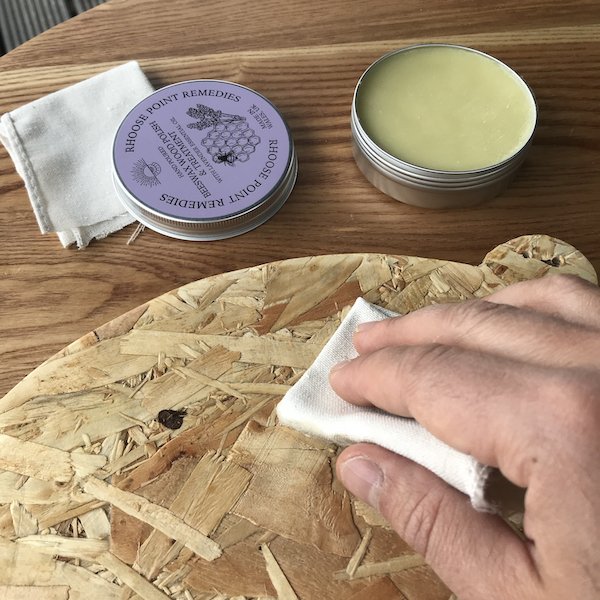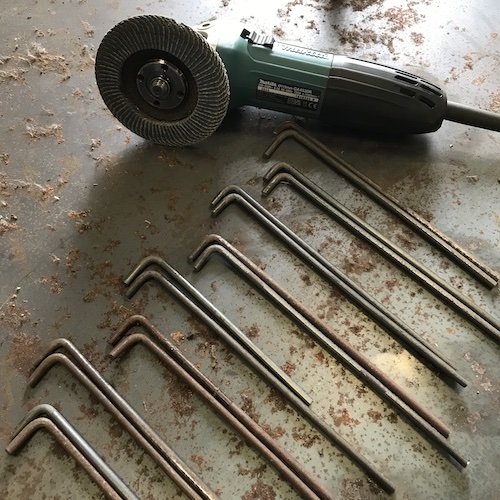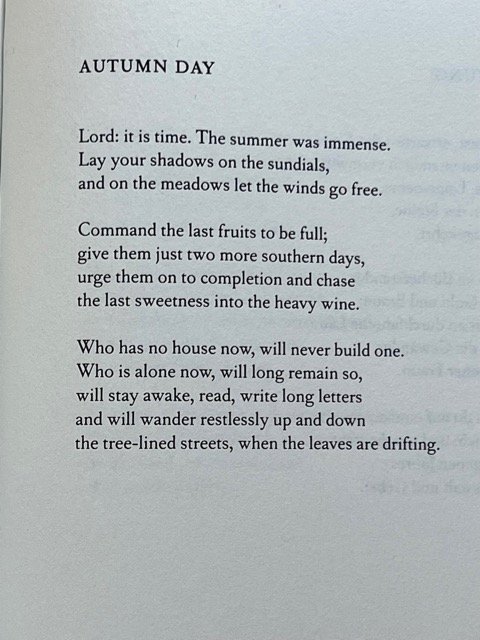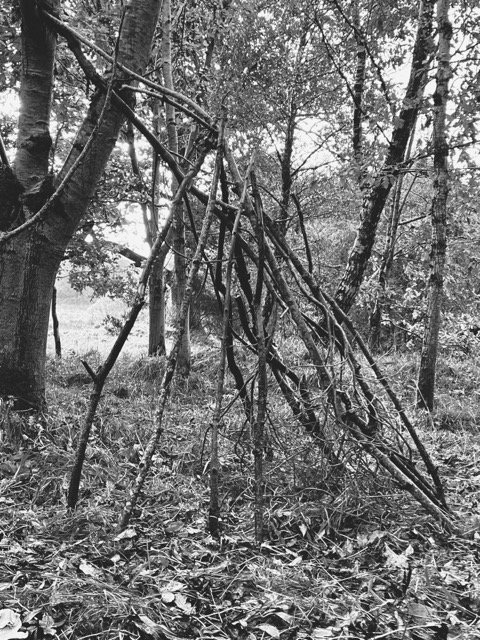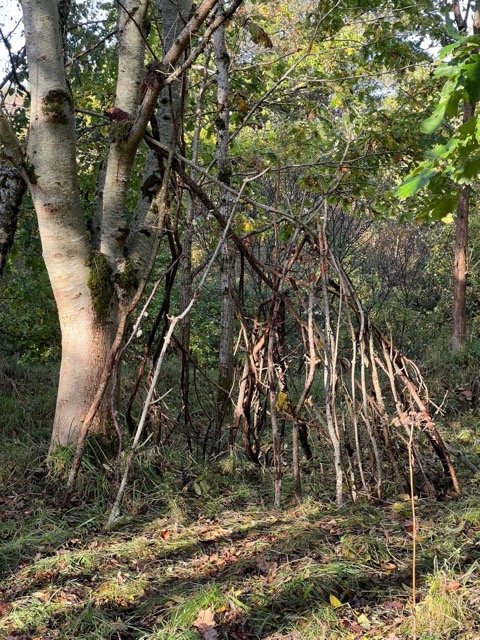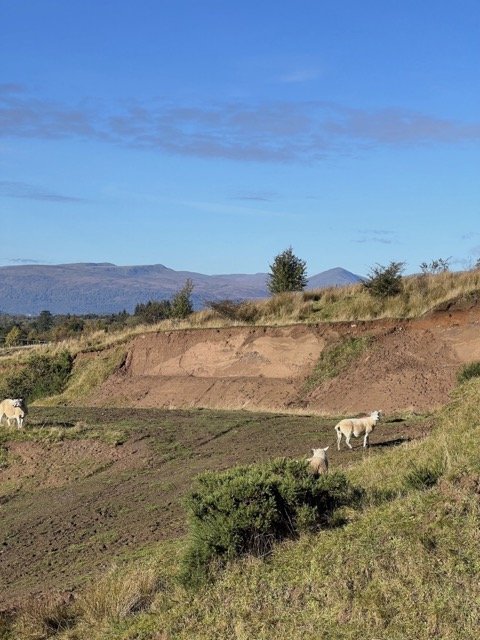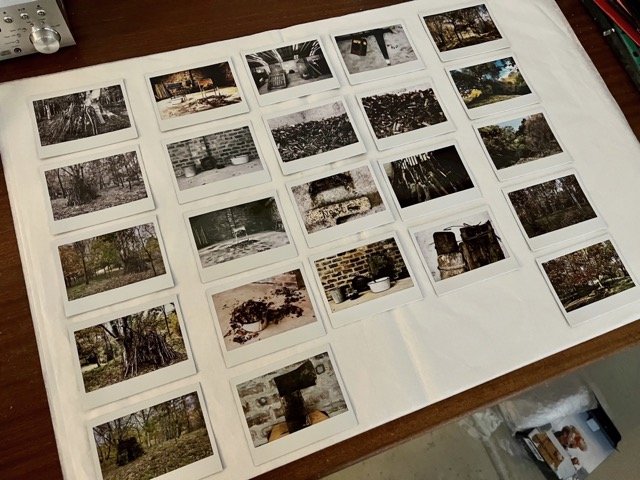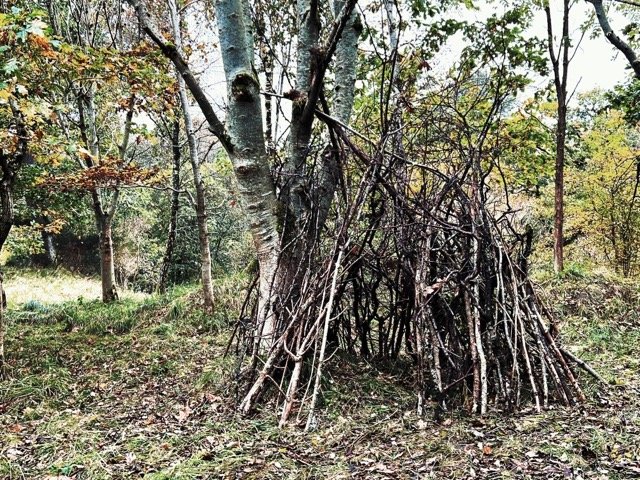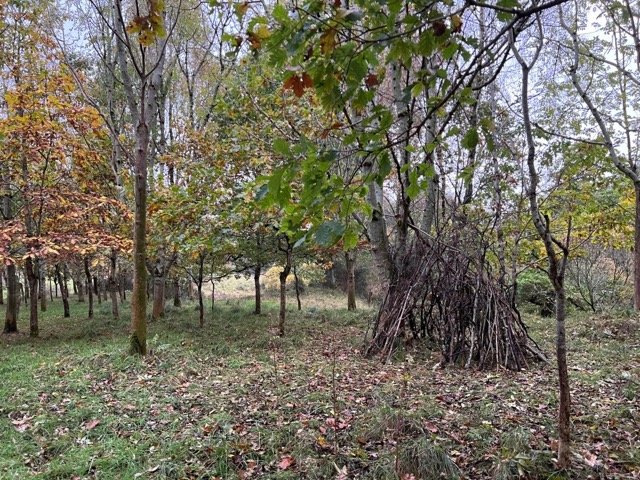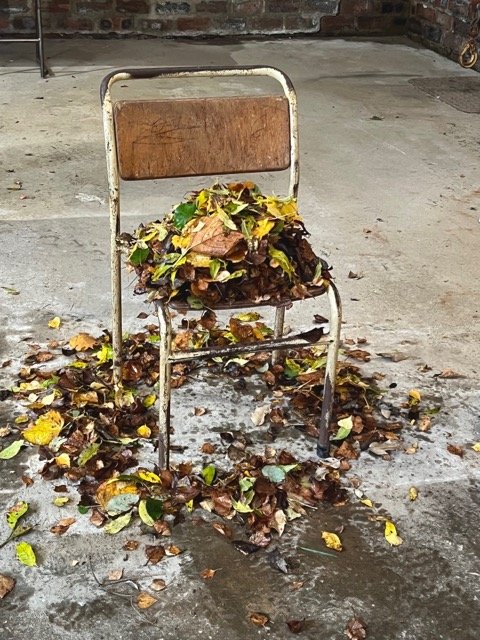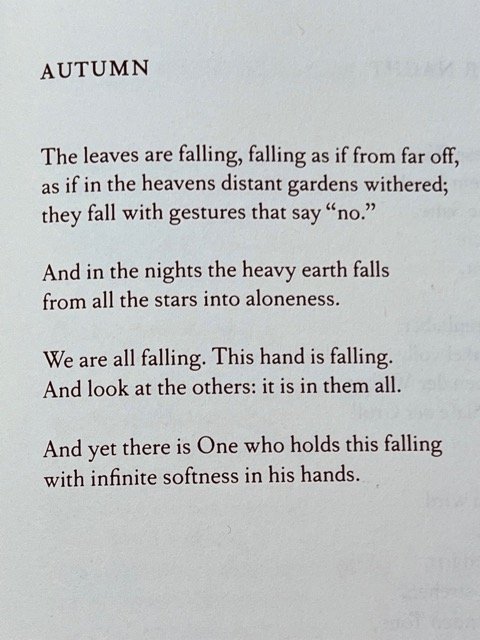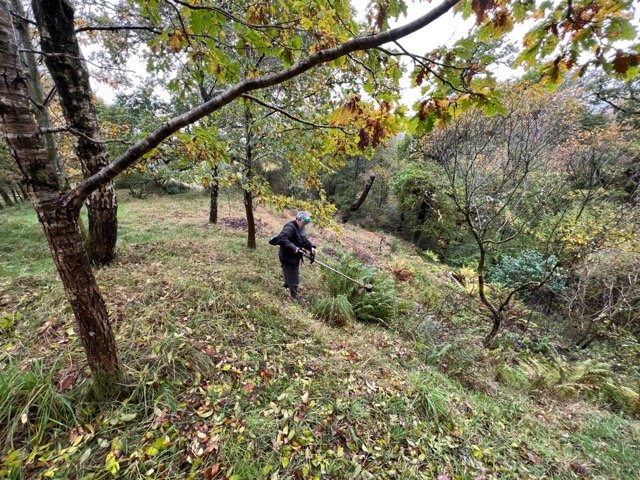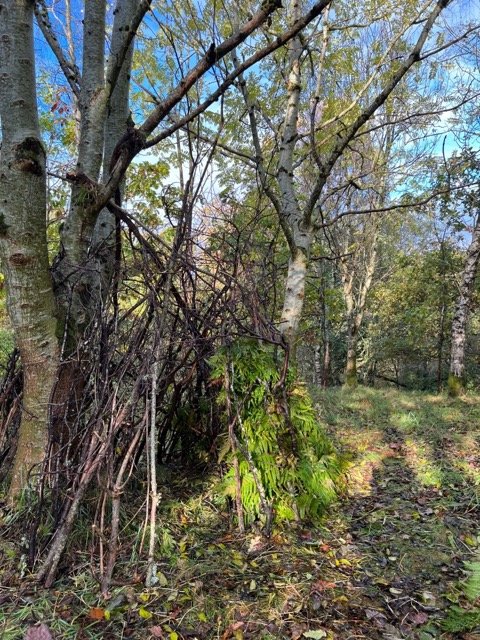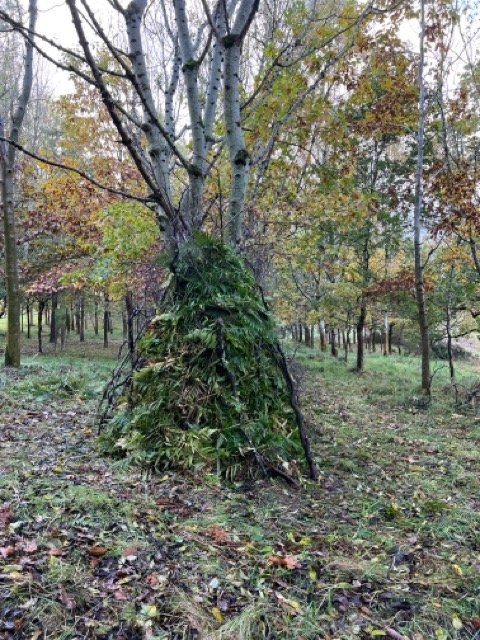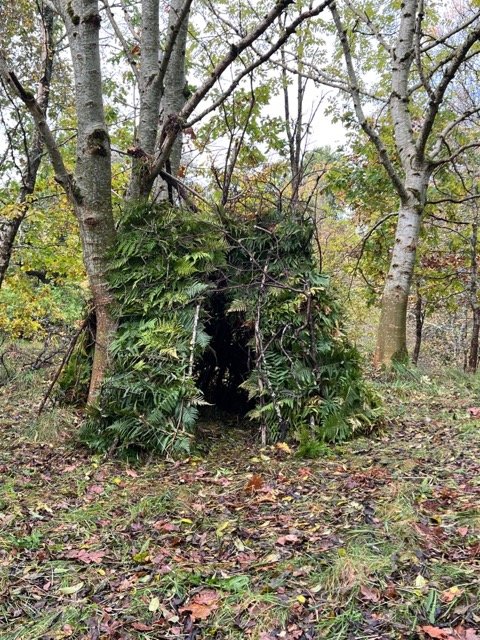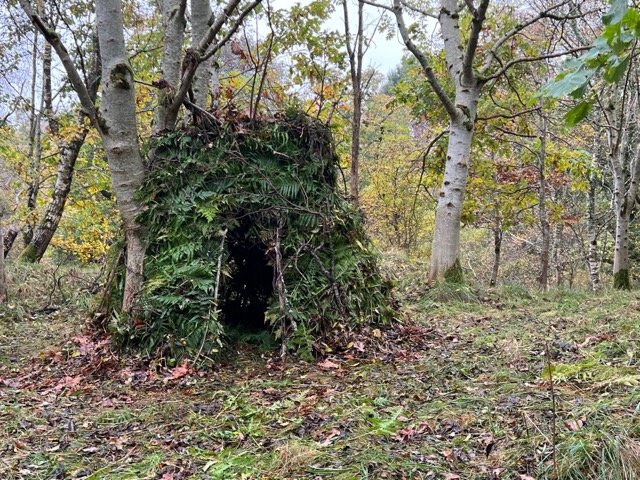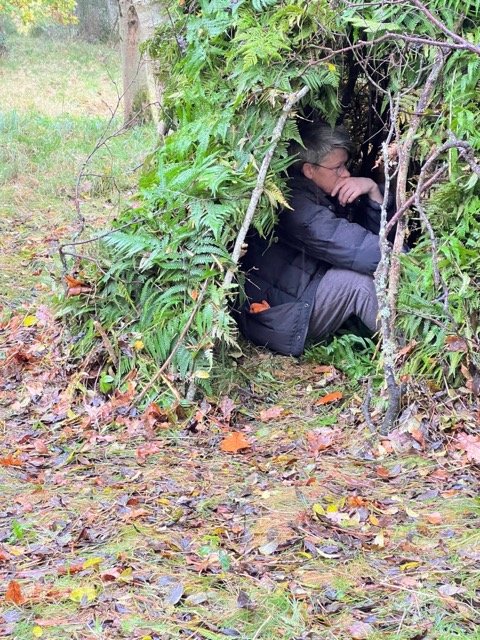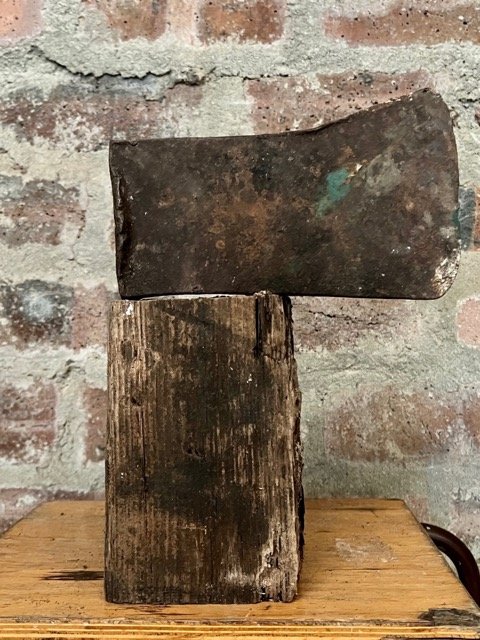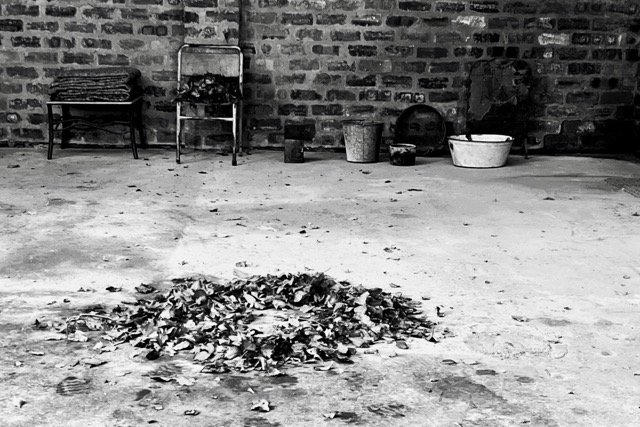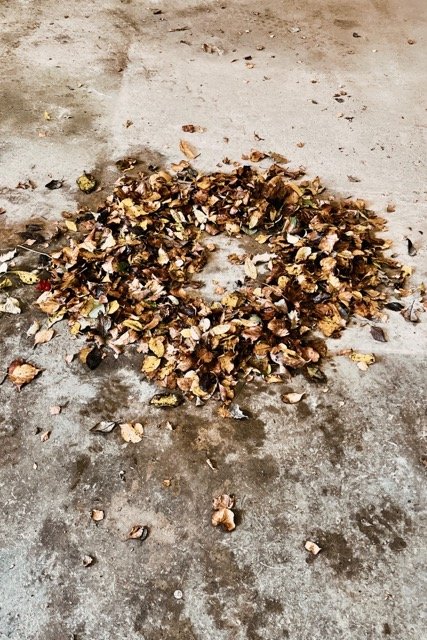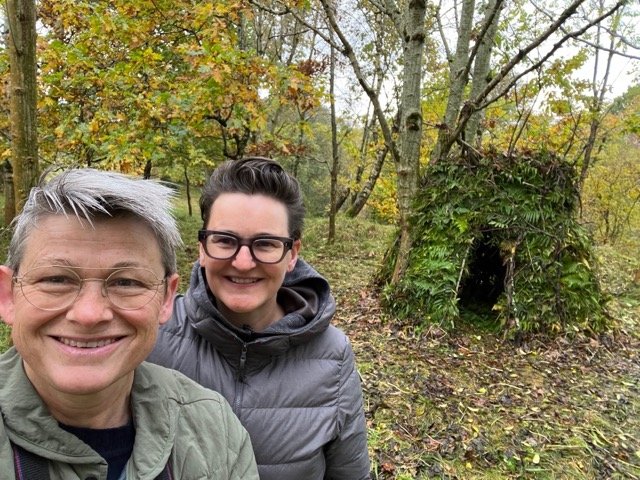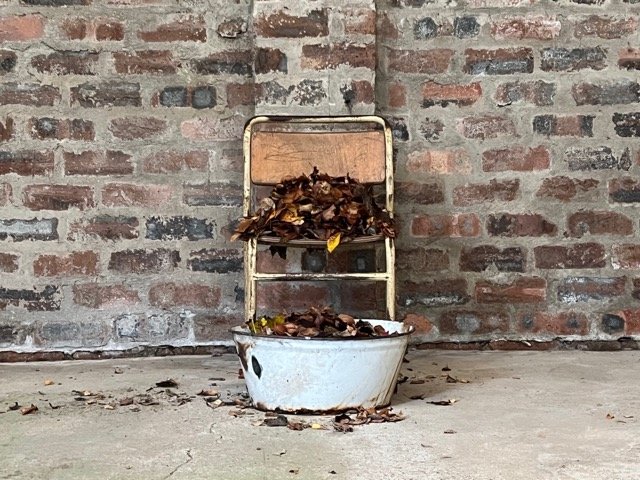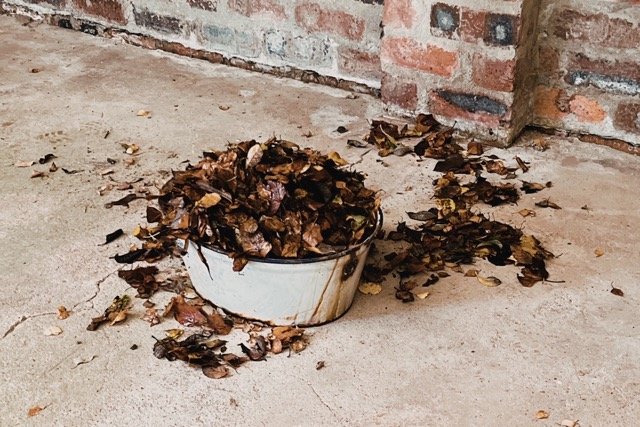
Arcadia Artist’s Blog
June 2024
Kate V Robertson
I spent a wonderful week at Arcadia, from 24th - 30th June 2024. I could tell instantly how restorative the experience would be, with everything I could ever ask for - a well-stocked and spacious workshop, outdoor work space, plenty of scrap wood to forage from, a lovely cosy cabin just for me, complete with a treetop vista over the beautiful surroundings of Drymen. Bliss.
The plan for the week was half pre-determined and half open, I had planned to build some supports/structures to display some bronze pieces I have made previously. I find it very hard to finish work in the studio, with the possibilities being endless and without knowing where the works will be exhibited, yet they need to be finished - at least provisionally - so I can move on with other pieces. So, I had decided to make wooden structures, loosely resembling AV stands and other ‘presentation’ furniture, such as lecturns. I had bought some second-hand wood (I try to avoid using virgin materials) and had pre-cut the parts I would need for around 4 such pieces.
The main idea for the week was to master the experiment with the Japanese technique known as Shou Sugi Ban. Originating in 18th Century Japan, Shou Sugi Ban is a method of preserving wood by charring it with fire. This ties in with my current interest in anachronistic sculptural practice, mixing the ancient with the modern and futuristic.
Burning wood
The first couple of days I spent assembling my pre-packed items and seeing how they burned. This had mixed success, I had tried to design for disassembly using dowel fixings, but this was very fiddly and measurements had to be exact - not my strong point. Come back screws, all is forgiven!
I initially was burning with a blow-torch, which was immensely satisfying to do - however I also quickly realised that some of the wood I had used was not ideal for this technique, which works best on soft wood with visible grain. I had thought that the charring finish would cover the fact that the wood was mismatched, but it didn’t. I had the best results on timber CLS, but that wasn’t the right shape for the pieces I was making. So, I didn’t have instant results but now have established
the basics of the technique and know how to progress with it. In future, using a chimney-shaped stack of wood to burn the surface in a fire would be the way forward, as in the original method. The blow-torch may be satisfying but it takes a lot of time to get enough charring on the wood. I will also burn everything before assembling too, as the joins were hard to char without destroying.
After I had assembled and charred all the pieces I brought with me, I thought it would be interesting to contrast found natural wood, direct from trees, with the industrially processed found wood I use elsewhere. My recent works have been preoccupied with manmade processes such as those associated with consumption or technology, and I thought using a natural ‘waste’ material might provide an interesting counterpoint to this aspect of my work. So, I collected various sticks, twigs and logs, from both the beautiful Sculpture Trail at Arcadia, and Rob’s firewood stash (which was both plentiful and ready-dried).
I used some of these tree bits in combination with the furniture pieces, and made some improvised items, which loosely resembled tripods or mic stands, which I found quite comic and reminiscent of older works of mine.
found wood objects
I also made some figurative pieces using twigs, which came to me during the week, in reference to Giacometti, who I am fond of. However these pieces - although were fun at first - were very fiddly to stick together, and very fragile, so mostly they didn’t work as well as I’d hoped - and certainly not built to last, and they broke almost as soon as I burned them. I did like this one piece that was a replica of Giacometti’s Hand, but I think it would need to be cast in bronze, as I had to fix it every few minutes, especially when documenting it al fresco!
Hand Twig sculpture, after Giacometti
I also took a couple of log sections, and was intending to try my hand at a totem pole type thing, which involved using a borrowed chain saw and palm router, neither of which I had used before. My unfamiliarity with the tools made the results mixed, but I also remembered that I always use found shapes or patterns, or incidental mark making, rather than drawing or carving, so this method didn’t really suit me. I found some man-made items such as a plug (for a sink) and a plug (for an appliance) and used these to make face shapes. I enjoyed seeing how I could get these sections to interact with each other, but I’ll need to rethink how to take this idea forwards. The best part of these were the incidental surface of one log which had both grain cracks and saw marks, I did a rubbing of this too and left that for the Arcadia Archive.
Trunk pieces
At the end of the week I staged a photoshoot to document the work I had made in situ. This was really fun, particularly the absurd image of me pushing random objects around in a wheelbarrow and improvising with it as a step ladder!
Documentation
Rob and Susan were brilliant hosts and I really enjoyed getting to know them, and was inspired by the life they had built for themselves and were willing to share with others, which was a real privilege. The undistracted absorption in work and nature was better than any holiday, and I feel really nourished and restored now, and grateful to Arcadia for the gem of an opportunity.
Group of pieces
Lecturn
Tree hand
Santiago Del Pozo
ARCADIA DIARY Develop Ideas
Day01
I have only been here for a few hours and I feel privileged. I am eager to get to know the place better and to start developing my project. A project thought in Arcadia and for Arcadia, but first I would like to share where I am starting from.
A few weeks ago, when I was offered this opportunity, I planned to approach this residency with nothing defined. With an empty mind, to live the experience in a freer way and take advantage of all the possibilities that the place offers, without limitations.
I must say that it has been impossible for me, it is difficult to change the way I work. I have a very active mind and I have been thinking about the word EMERGENCE and its meaning for days. A meaning that must be interpreted and understood in its original context.
I have come with some sketches in my mind, somewhat blurred. Some of them will probably fade away during my stay and others will emerge, or at least I hope they will.
But I want to use every minute to explore this unique place. With the permission, of course, of our friends the midges!:).
To do so, I see fieldwork as essential and collect useful samples that will help enrich my practice.
Greetings from Arcadia
I have thought of doing it in two ways: the first would be to collect all kinds of seeds that I come across and later, when I return to my workshop in Edinburgh, I will continue working on them.
The second way will be with the collaboration of the passage of time and the natural environment. I have thought of placing circular pieces of carpet on the floor. These will be scattered in different carefully chosen locations, clear examples of the diversity of the environment. The aim will be to record any type of natural life in the environment. Observe how the natural environment interacts with the pieces and what emerges from them.
I am a little clearer about the way I want to work, with a work philosophy that I have been developing for some years now and which is based on respect for the environment.
For me, working in a sustainable way has become a necessity and does not have to be incompatible with contemporary art, but rather the opposite, an ally. That is why the whole of my practice is involved and revolves around this idea. This includes the concept, the materials and the way they are found, collected, treated and worked. Trying to produce 0 emissions and 0 costs. Relying on the practice of recycling as the main protagonist in this creative process.
Day02
Today I combined workshop work with field work. In the workshop I worked with recycled materials: wood and carpet. I have made progress in the manufacture of the pieces which will be placed in points of interest in the natural environment of Arcadia.
Bearing in mind what they are designed for, I thought it appropriate to give them a circular shape, making reference to Petri dishes, laboratory utensils used in biochemistry for the study of microorganisms.
Recycled materials
Each piece is made up of two parts joined together. The wooden part is to make it more resistant and will be anchored to the floor and the carpet part will be visible, exposed to the elements to record the mark that nature will leave after the passage of time.
For the moment the aesthetics of the pieces is secondary, we will have to wait and let the elements collaborate to see this transformation from ugly duckling to swan.
Work in progress
I also spent some time exploring the surroundings. With magnifying glass in hand the afternoon flew by as I observed the local flowers and their friends the bees.
Now time to relax in the cosy hut and enjoy watching the sunset.
Detail of a Digitalis purpurea
Day03
One more day in the workshop and The Arcadia Cells are almost ready. I hope they will see the light of day in the next few days.
Sanding the parts to be assembled
The Cells of Arcadia is the title I have chosen for this bio-sculptural installation.
I think the colour of the carpet was a good choice. It is a very discreet grey and will not alter the harmony of the natural environment. My intention is that the pieces will blend in and end up forming part of it.
Day04
Today I used the day for contemplation and inspiration. A very important part of the creative process.
Feeling the inspiration
Contemplation of the environment
Blending in with nature
The sun has shone and it has given me the opportunity to explore Arcadia at its best. I show you the path that leads to how I imagine paradise, with the two things I like most in this world, Art and Nature.
Day05
I left the pieces glued yesterday afternoon and today I found them dry and ready for the final finishing. I have applied a couple of coats of beeswax to protect the wood from the weather and to make it last until our next meeting in 6 months. At that time, I will photograph and report on the progress of each of them.
Finishing touch
In between layers, I have taken the opportunity to assemble other smaller pieces to found trunks. Prototypes of experimental bio-sculptures created in collaboration with nature.
Bio-sculpture
Looking at the surroundings of Arcadia and the buildings that house the workshops I think the pieces will be successful. Interesting how nature grows over any architectural element. It comforts and inspires me how these two worlds coexist.
Nature and geometry
Day06
I am very excited to start with the installation of the pieces. Once I have decided where they will be placed I start to make the pegs with which they will be fixed to the ground.
Preparing Installation
Pegs ready
The most important moment came, showing them their new home and saying goodbye to them until our next meeting.
See you soon Arcadia Cells
Day07
After a week of intense work it is time to rest. I see no better way to do this than by visiting the natural surroundings of Arcadia. Nearby, just a few miles away is Balmaha, a small village on the eastern shore of Loch Lomond and the point where the Scottish Highlands begin. I decide to climb the iconic Conic Hill and see the beautiful views it offers of the loch and islands.
View of Loch Lomond from Conic Hill
In the evening, farewell dinner in the best company; Rob, Susan and Suzanne. I only have words of thanks for them. Thank you very much for allowing me to live this experience.
Farewell Arcadia!
October Residency 2023
Sidney Taylor
Hi there! I’m Sidney Taylor and I had the wonderful opportunity to visit Rob and Susan Mulholland at the Arcadia Sculpture Centre near Drymen, Scotland for a week from Saturday October 28 until Friday November 3, 2023. I am a Watson Fellow from the United States pursuing a yearlong self designed project titled “How Art Builds Community, How Communities Build Art”. For my project, I’m connecting with international communities of artists and engineers to ignite imaginations through collaborative and community focused large scale sculpture builds and to learn how effective workshops are started, funded, and maintained. Through my project, I’m also seeking to explore the question “What types of creative environments empower communities?”.
While at Arcadia, I was hands-on in the metal shop gaining experience and helping fabricate an orb sculpture. When not in the shop, I was chatting with Rob and Susan, exploring the local countryside, practicing my fiddle, and helping out with tasks around the property. I was the lucky first visitor to stay in the new artist in residence cabin on site which is just around the corner from the workshop and courtyard.
Huge thank you to Rob and Susan for everything this week!
Artist’s cabin
October Residency 2022
Audrey Grant
17/10/22 - MONDAY
I arrived, accompanied by my partner to Arcadia Sculpture Centre, near Drymen, the old Drumbeg Farm. Unloaded, unpacked and settled into our cabin in the woods.
I have come here with some ideas - the poems about autumn by Rainer Maria Rilke and inspired by lines from the poem Autumn Day - to build a woodland shelter. Something I have never done before but I want to leave something here in this golden landscape from nature, and that would return to nature.
My thoughts: autumn; history and objects; How to build a shelter; the woodland - oak, birch, ash and sycamore; and fallen branches
Falling beauty..
What is a shelter? Protection from the elements; a protective layer; a shelter for our vulnerability.
We walked the Sculpture Trail and found a spot in the new woodland and began to build a shelter amongst the trees, a solitary shelter, a small intimate shelter for protection, for reflection, for contemplation.
We gathered branches of all lengths from the forest floor, we found a tree with a good ‘V’ shape to place the backbone branch, from which others would be wedged against to make the ribcage for the structure
The ground was wet, everything was wet, the rain and wind bellowing around us but we continued until the light began to fade.
A good start, a good beginning of my shelter in the woodland in Arcadia.
It sounds like a contradiction to say we need such a shelter in Arcadia, but even in Arcadia we are mortal.
ET IN ARCADIA EGO
18/10/22 -TUESDAY
A new day, bright sunlight through the trees, the golden light is incredible. Thinking of Thoreau at Walden Pond, I have much more luxury but that sense of being deep in nature, somewhere else removed from the rest of the world.
10am A walk around to see if what we started yesterday still stood? Intact and beautiful in the golden light.
Then a walk to explore the area, to find the old sand quarry. Along the path and into the fields where the sheep grazed. An undulating surface, post extractive, the ground wet and pools filled with bullrushes.
After lunch I went to explore the old barn and stables - what a wonderful place, so much history here:
old stables, horses names still on the doors,
metallic basin
metal pot
rusty horseshoes
11 school chairs
3 blankets
fire wood pile
old lamp and saw
old machinery
Thinking about a Plan for an Installation
Poor Objects; Everyday objects; Discarded objects; Object with history; multiples
Traces of the past; left behind, the previous life of an object when it was of use, now forgotten, discarded. There is a sort of melancholy about this old barn.
Then back to the woods to gather more big and long branches for the shelter, dragging huge branches up from the lower woodland.
Exhausted at 5.45pm
19/10/22 - WEDNESDAY
Plan for today:
Continue to work with found objects in the barn
Continue to build the shelter
Print some images using new Instax wide printer
The shelter has a structure now, feels like it has some substance to withstand the next layer - fern leaves to be woven into structure.
I set up a little indoor studio space that Rob said I could use. Shown around his studio workshop and the other buildings - what a treasure trove!
Thinking more about Rilke and a sequence of poems from the Book of Images, First book part two:
Lament
Solitude
Autumn Day
Autumn
Memory
End of Autumn
Rilke ‘ the poet of memory; of childhood; of leave-taking and looking; of night and its vastness; of human separation; of thresholds and silences; of landscape charged with remoteness and expectancy; the poet especially of solitude in its endless inflections’ (Edward Snow)
How much the place suits Rilke …
After lunch, pottering in the studio space with some found small pieces of wood, layering them with lithium grease then gauze bandages. Little sculptural objects.
20/10/22 - THURSDAY
Dark and very damp today and worried about the shelter as there were very strong winds last night so I walked around first thing to check - and it is still standing tall and proud!
After reading more from Gaston Bachelard’s ‘Poetic of Space’ I’ve been thinking about the immensity of the forest and the solitariness of the shelter. A shelter for the solitary dreamer for the day dream.
Raining all day
Working in the dry studio space after lunch, and continuing to work on the little sculptural objects, layering more and more lithium grease and more layers of gauze, plus a special beeswax paste I made. Back in the barn, leaves had been blown in and had landed on the school chairs. This got me thinking and experimenting, so collected handfuls of leaves from outside and let them fall onto the seat of one chair. I piled them up until they began to fall onto the floor and created a ring of leaves. The leaves are falling, we are all falling
The metallic basin somehow relates to this.
I’d been printing photographs to get a better look at what was emerging - three basic groups:
1. The Shelter and its progress
2. Objects and surfaces in the barn
3. The Arcadian Landscape
4. Small sculptural objects
21/10/22 FRIDAY
NOT raining today so collected the strimmer from Rob to cut down the fern. Again with Mary’s help we collected piles and piles of fern leaves.
We began to weave the leaves into the structure.
Several rounds of exhausting activity required to have enough ferns.
Flocks and flocks of geese flying north as they have all week. I find their sound so moving
The shelter as a place for daydreams but also for shelter from the rain and the wind. Maybe not so watertight!
Amazing to spend most of the day working outside, physical labour, building my own shelter.
I reflect upon our relationship with nature, and how out of kilter it can be. What so many of us can take for granted yet everything is so fragile and transient.
Only one full day left!
22/10/22 SATURDAY
Started the day with more work on the shelter to complete it today. Collected handfuls of fern leaves to finish. Started to put handfuls of fallen leaves on top of ferns but this didn’t work so we stopped but they were useful for the roof of the shelter which was hard to reach. Mary raked the ground around the shelter, and I sat inside the shelter to contemplate. I need more time for contemplation and reflection - what it took to build it; the physical effort required; we were fortunate as there was plenty of materials in the forest - what if there weren’t?
The rain was pouring now so spent the rest of the afternoon in the barn creating a series of ‘still life’ set ups, photographed them using Iphone and analogue film camera.
Still to photograph shelter, Sunday’s job before leaving.
23/10/22 SUNDAY
All packed up, vacated cabin by 10am. Car packed and time for a walk to the shelter for a final look and to photograph using Nikon camera.
The week flew by, and I built a shelter in the woods for the Arcadia Sculpture Centre, build from nature and it will return to nature as it decays over the coming months.
An incredibly wonderful and creative week with so much to take away and work on back in my Edinburgh studio. Thank you very much Susan and Rob Mulholland for having me!
Audrey Grant 2022
Artist’s Residency September 2022
This is Deniz Uster. I’m an interdisciplinary artist whose collaborative approach is rooted in anthropological, ethnographic and scientific research, interwoven with speculative fiction. A fictional shift in nature in my narratives forms the foundation for alternative social structures, collectivities, cultures, economic systems, futures and histories.
During my week-long residency at Arcadia, I laid the groundwork for my utopian fiction film ‘Drymen Phenomenon,’ through community workshops, discussions and bryological research at Arcadia’s ancient woodland - the environmental trail. Below paragraphs will explain the conceptual framework of this collaborative project, and the nature of my social-engagement with Drymen Primary and local musicians.
Covid-19, in the narrative of 'Drymen Phenomenon', has completely diminished from human bodies and has become absorbed by Thuidium tamariscinum moss found in Drymen and its vicinity. When the residents get exposed to the spores of this Covid-19 infused moss, it becomes apparent that these spores induce ‘synesthesia’ in human beings. Nature transforms us through this new ability and this is acknowledged as an evolutionary shift. For the narrative of the film, I will be working with author Gurcim Yilmaz, who will pen a fictional text; field-notes from the mouth of a botanist, informed by the words generated at the synesthesia workshops with P4/5 pupils from Drymen Primary.
During my initial visit to Arcadia, I collected bryophyte specimens. Bryophytes are non-vascular plant species such as moss, liverwort and hornworts that reproduce via spores rather than flowers or seeds. I have identified nine species with support from the British Bryological Society and eventually chose Thuidium tamariscinum moss (aka Common Tamarisk Moss) as my protagonist due to its population in this particular woodland, and its attractive and sensual properties.
Considering ‘synesthesia’ as the convergence of two senses has provided a fertile ground for community workshops, prior to my filming. On the first day of my residency, I harvested Common Tamarisk Moss from the environmental trail, and nurtured them in their tray for the duration of my residency, to return them back to their original locations at the end of the week. I conducted an olfactory-tactile synesthesia experiment at my cabin, as I possess a powerful smelling ability and I love making objects.
On Tuesday, I met with Dave Lang at his incredible studio in rural Gartmore. Dave was immediately very open to experimenting with anything, as long as he could use his music as his tool. He is very powerful at it, and the most enthusiastic! As soon as he interacted with Common Tamarisk Moss, Dave began thinking about organic rhythms , with a certain darkness added to them, when you least expect to hear them. We chatted about the vibrations and the fluctuations that its fern-like pleurocarp structure evoked. The recollection and an edited version of all music and sounds created, will be embodied as the sound or “the call” emitted from “Drymen Tamarisk”; the Covid-19 infused Thuidium Tamariscinum.
The core of my residency project; my workshops with pupils from year P4/5, at Drymen Primary were taking place on Wednesday. There were two moss workshops back to back, then my artist presentation on “Interdisciplinarity” in art practice and “collaborative working” to P5/6 students.
The moss workshops with 8 and 9 year-olds turned out exactly the opposite of what I presumed. I prepared countless prompts for answers to my tricky questions, in the probable case of prolonged silences, but they had loads to tell! I had such a positive experience with the different dynamics and mood of both groups and their unexpected creative answers.
“The moss smells like… marshmallows… fish tank… colour green.. cold water… raspberries…”
“The moss sounds like… waterfall…. loud humming… wind howling… washing machine…. “
“The moss feels like… wet feather… twigs… my mum’s hair… and most popularly; a hedgehog with soft spikes.”
On Thursday, marvellous Di Blackmore visited Arcadia with her tin whistle. She was instantly engaged with the moss, following my presentation on Synesthesia at the old stables.
Her eyes focused on the smallest surface naked eye can see, and said “It’s fractal!” Each little branch was a replica of the one that it originates from. She then took her whistle, and began imitating the fractal growth or fractal shrinkage of Tamarisk moss. She said, "You’d need an orchestra to mimic its fractal becomings."
When I came to my cabin and imported the recorded sound into my editing program, I noticed that the graphic for the levels of the sound on the track was mimicking the form of a tamarisk moss branch. I had the tapering tip, and I had the same fluctuations of the minuscule moss leaf.
I have learned so much from my workshops and it very straightforwardly influenced the script of the film, and what I want to achieve with the filming. I am very grateful to all participants and Arcadia for enabling me to reach out to those people.
On Friday, I returned all borrowed moss back to their original locations. No moss was harmed in the making of this project.
Welcome to our Artist’s Blog page.
We are delighted to have had Deniz Uster as our first Artist in Residence here at Arcadia Sculpture Centre this week and we look forward to reading all about her fascinating project ‘ Drymen Phenomenon’ The Sculpture centre is now fully operational and we have had several artists visit with plans to undertake new work. This Blog page will give you an insight into their art practises and links to their own websites to gain more information on their work. We look forward to hosting a wide and varied representation of contemporary art undertaken at Arcadia.
Deniz Uster Artist in Residence September 2022





















